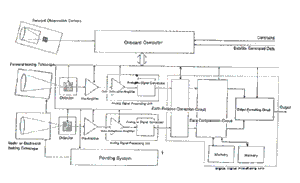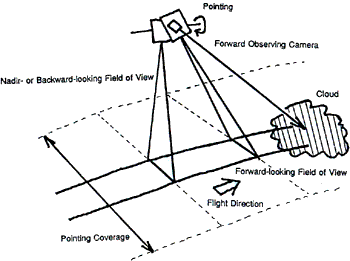| GISdevelopment.net ---> AARS ---> ACRS 1991 ---> Mapping from Space |
Conceptual study on
forthcoming very high resolution Visible and near infrared radiometers
Riichi
Nagura
Yoshito Narimatsu, Jun Tanii, Masaru Hiramatsu
Kazuhiro Ogikubo and Shinichi Nak jima
NEC Corporation Space Development Division
4035, Ikebe-cho, Yokohama, 226 Japan
Yoshito Narimatsu, Jun Tanii, Masaru Hiramatsu
Kazuhiro Ogikubo and Shinichi Nak jima
NEC Corporation Space Development Division
4035, Ikebe-cho, Yokohama, 226 Japan
Abstract
This paper introduces a forthcoming visible and near infrared radiometer on board satellites which meets all requirements in the field of Earth observation. This radiometer is called the Super VNIR. The Super VNIR has more than three spectral bands in the visible and near infrared range and utilizes the highest spatial resolution of 4m (2m is possible). Along-track color stereo images can be obtained. Therefore it is greatly expected that this radiometer will contribute to the improvement of the measurement of topography, classification of geological materials and discrimination of the land utilization and vegetation. The concept of intelligent imaging a radiometer which autonomously controls its operation by means of an onboard computer is indispensable for the utilization of this radiometer and is also mentioned in this paper.
Introduction
In recent years, observations of the Earth from satellites are widely performed and many future observation missions are planned. Especially, observation in with radiometers in the visible and near infrared region has obtained very good results. Landsat (U.S.A), SOPT (France) and the Japanese MOS-1 and 1b are now successfully in operation and providing much valuable data. Moreover, many remote sensing satellite missions such as prospective Landsat and SOPT, the Japanese ERS-1 (to be launched in 1992) and ADEOS and the EOS project of the United States are planned.
NEC Corporation has developed the MESSR (Multispectral Electronic Self – Scanning Radiometer) of MOS-1 and 1b under contract with the National Space Development Agency of Japan (NASDA). NEC has also developed the OPS (Optical Sensor) for ERS-1 under contract with the Japan Resources Observation System Organization (JAROS). Under contract with NASDA and JAROS, NEC is now developing the OCTS (Ocean Color and Temperature Scanner) for ADEOS and the ASTER (Advanced Speaceborne Thermal Emission and Reflection radiometer) for the EOS platform, respectively. The OPS has been developed and the ASTER is now being developed under the guidance of the Ministry of International Trade and Industry (MITI).
The technique of data utilization has made great progress as much data from satellites have been provided. In the near future the radiometers should provide imagery services of better quality in various fields.
This paper introduces a forthcoming visible and near infrared radiometer featuring high performance which meets such requirements.
Presented at the 12th Asian Conference on Remote Sensing, at Regional English Language Center, International House of the South East Asian Ministers of Education Organisation (SEAMEO), Singapore, October 30 to November 5, 1991.
Main Characteristics of the super VNIR
In addition to an improvement in the quality of image data, the autonomous image processing in robit should be adopted for radiometers in the near future. It is called the intelligent imaging. Intelligent imaging refers to convenient and highly efficient acquisition of image data and so on. In this section the main characteristics of the Super VNIR are described.
(1) High Spatial Resolution
The highest spatial resolution of a radiometer for Earth observation is at this time 15 to 20 m for multiband and 10 m for panchromatic. The Super VNIR improves spatial resolution and obtains detailed information. Theoretically or from the view of optical design, a resolution of 1 to 2m or more is possible. However the Super VNIR should satisfy interface conditions for satellites in terms of weight, power consumption and data rate. Moreover the Super VNIR should be adaptable to the present architecture of the Earth observation system. Therefore resolutions of 4m for multiband and 2m for panchromatic are suitable and realistic for the Super VNIR. A wide swath width of 80km is available by using 15,00 to 20,000 element CCD ( Charge Coupled Device ) sensors as detectors.
(2) Improvement of Stereoscopic Image Information
The Super VNIR provides along-track stereoscopic image in multispectral bands. Stereoscopic imaging at this time in orbit is mainly performed between the neighboring orbits--- in other words, in the cross-track direction. Adoption of the along-track stereo imaging makes the observation time intervals between two stereo pairs extremely small. By means of combining color images from different view angles, the capability of recognizing an object is advanced.
The digital elevation mode (DEM) is generated from the stereo pair and the height resolution is in proportion to the spatial resolution. Therefore with the Super VNIR’s high spatial resolution a highly accurate DEM can be obtained. The Super VNIR is planed to use data from a laser altimeter together. The absolute height obtained from the laser altimeter compensates for the DEM which is obtained from relative undulation information on stereoscopic image.
(3) Selection of the Imaging Area and Variable Stereoscopic Imaging Angle
The stereoscopic imaging angle in the along-track direction is varied, enabling the most suitable base to height (B/H) ratio to be selected according to the conditions of the target, such as the inclination, surface coverage and so on. In order to satisfy the urgent requirement of observing off-nadir places, the Super VNIR has a wide pointing capability in the cross-track direction. The pointing is performed by rotation two telescopes around the identical axis so that the alignment between the tow telescopes is precisely maintained
The Super VNIR employs a forward observation camera which has a wider view and observes ahead of the forward-looking telescope. With the information from the forward observation camera, the distribution of clouds for example, the onboard computer decides the operational mode, imaging spectral band, stereoscopic angle, pointing angle and so on. Consequently highly efficient data acquisition is realized and various observational requirements are satisfied.
| Items | Characteristics |
| Spectral Resoflution | 4m (2m for panchromatic |
| Spectral Range | More than 3 bands in visible and near infrared region |
| Stereoscopic Imaging | In the along-track direction color stereo image Variable base to height ratio Automatic correction of the effect of the rotation of the Earth |
| Pointing | By rotating two telescopes simultaneously |
| Telescope | Two telescopes Focal length (f) = 2.0 – 2.5m |
| Detector | Si CCD sensor 15, 000 – 25,000 photo diode elements |
| Absolute Radiometric Accuracy | ±4% |
| Other characteristics | Data CompressionIntelligent imaging with forward observing camera |
(5) Onboard Correction of the Effect of the Earth’s Rotation
As for the along-track stereoscopic imaging, there exists a time lag in acquiring the image data from each telescope for the same area on the ground. That causes the an position displacement which is due to the Earth’s rotation. The degree of displacement varies with the orbit position of the satellite. The Super VNIR can correct this based on the orbital position telemetry data. This correction contributes to a reduction of the data rate.
(6) Data Compression
The high spatial resolution and multispectral stereoscopic imaging increasing the amount of data. The data rate is estimated to be more than 1 Giga bit per second. It is very difficult to transmit such a large amount of data to the ground. Using the correlation among image data in all spectral bands, the Super VNIR compresses its data rate into one fourth (1/4). The information obtained by the forward observation camera is effectively used in the data compression. This enables the capacity of the on-board memory to be smaller and its weight, which is severely restricted, to be lighter.
(7) High Registration Accuracy
The Super VNIR employs linear CCD sensors as detectors. NEC Corporation has developed many kinds of space borne CCD sensors and has adequate experience in this field. In order to realize high registration accuracy, The Super VNIR employs color CCD sensors. For reasons of image data processing and optical design, Photo diodes on the same chip arranged in lines parallel to each other in the cross-track direction are the most suitable for the Super VNIR. Because for the adoption of color CCD sensors, no band splitting optics are necessary and the construction around the focal plane is simplified.

Figure 1. The functional block diagram of the Super VNIR

Figure 2 The external view of the Super VNIR
The insturmentation of the super VNIR
In this section we introduce the instrumentation of the Super VNIR. Major parameters and characteristics of the Super VNIR are shown in Table 1. In this study the altitude of the satellite is assumed to be about 700km. The functional block diagram, external view and schematic figure of imaging are shown in Figure 1, Figure 2 and Figure 3, respectively.
As can be seen in Figure 2, the Super VNIR consists of two telescopes for forward-looking and nadir – ( or backward-) loading, detectors, an analog signal processing unit, an digital signal processing unit, a pointing system, a forward observation camera and an onboard computer. It is of course possible to perform stereoscopic imaging with one telescope with a wide view angle. However, to obtain a large B/H ratio, which is variable and with a high resolution, using two telescopes is preferable.
The incident light into the telescope reaches the detectors and signal and analog signal processing unit performs analog to digital (A/D) conversion. The analog signal processing unit has a gain selection function. The digital signal processing unit extracts from a digital data of borth forward-and nadir- (or backward-) looking data so that stereoscopic viewing is available and after that it compresses the data. The digital signal processing unit has electrical interfaces such as image data, command and telemetry with the satellite. The digital signal processing unit has memories. The pointing system rotates two telescopes simultaneously in the cross-track direction.
The forward observing camera has a wider view and looks ahead for the forward-looking telescope. From the information gained by the forward observing camera, the onboard computer controls the Super VNIR/s operation mode.

Figure 3. The schematic figure of imaging
Conclusion
In this paper, the concept of a forthcoming very high resolution visible and near infrared radiometer has been introduced. The radiometer is called the Super VNIR. We believe the Super VNIR will play a large role in the field of Earth observation. We are ready to develop the Super VNIR by applying our various heritages on space borne radiometers. The next design phase for the Super VNIR will start in Oct. 1991 using the computer simulation and trial models.
Acknowledgements
The authors would like to express their sincere thanks to the Ministry of International Trade and Industry (MITI), the Japan Resources Observation System Organization (JAROS) and the National Space Development Agency of Japan (NASDA) for their continued encouragement and support. Thanks are also given to every cooperator.
References
- Y. Ishizawa, R. Kuramasu, R. Kuwanno and R. Nagura. “Multispectral Electronic Self-scanning Radiometer for MOS-1”, XXXI Congress, International Astronautical Federation, 1990 (Tokyo).
- Y. Narimatsu, M. Hiramatsu, R. Nagura, M. Takei and H. One, “Optical Sensor System of JERS”, Proc. Society of Photo-optical instrumentation Engineers (SPIE), Vol. 1490, 1991 (Orlando).
- J. Tanii, T. Machida, H. Ayada, Y. Katsuyama, N. Iwasaki, Y. Tange, Y. Miyachi and R. Sato, “Ocean Color and :Temperature Scanner (OCTS) for ADEOS”, ibid.
- H. Fujisada and A. Ono, “Overvieew of ASTER design concept”’ ibid.
- F. Takahashi, M. Hiramatsu, F. Watanabe, Y. Narimatsu and R, Nagura,m “Visible and near infrared (VNIR) subsystem and common signal processor (CSP